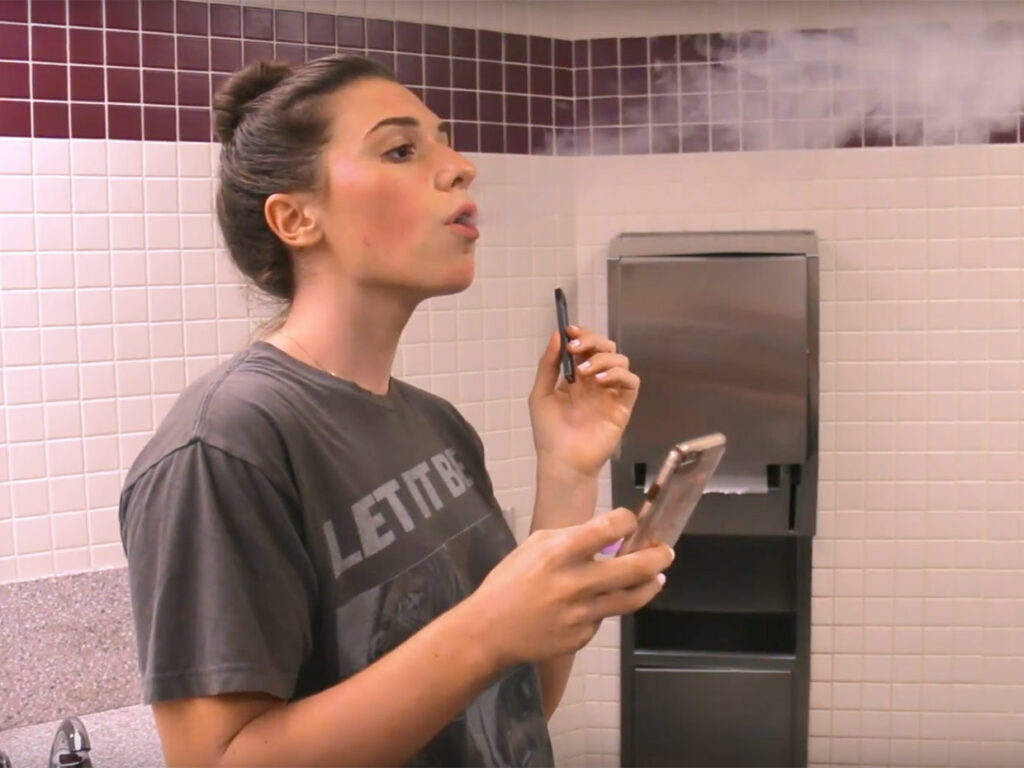
During the close I ask the high school students 6 questions. I let them know if they answer yes to one question they are headed in the right direction for an addiction. If they answer yes to 2 or all 6 of the questions, they may be well on their way. I also let them know if they feel anxious or nervous after the question, they need to see an adult they trust or their school counselor. I also let them know that it will be easier to quit now than if they continue to use.
Question #1
If you know somebody who has ever smoked in class. Example-The teacher turns their back they take a real quick puff off their vape, blow the smoke into their shirt or fan it behind them and giggle. This is a huge sign of an addiction.
The reason why this is a huge sign of an addiction is because they are willing to break the rules to use an electronic cigarette. They may understand the consequences of what they are doing and they’re willing to accept those consequences. Addiction can lead to a range of risky behaviors, including taking huge chances. People with addiction may engage in risky behaviors to obtain drugs or alcohol, such as stealing or driving under the influence. They may also engage in risky sexual behavior, which can lead to sexually transmitted infections and unwanted pregnancies. In addition, people with addiction may be more likely to engage in self-harm or suicidal behavior
Question #2
If you know anybody who goes in and out of the bathroom a whole bunch in between classes to use their vape this is a huge sign of an addiction. They may even go into the bathroom or ask permission during class to go to the bathroom understanding that they don’t need to use the restroom they just want to take a hit off their vape.

People or students with addiction often try to find places and times to use drugs or alcohol. According to Rehabs.com, the people, places, and things you experience every day play a vital role in encouraging or discouraging substance use, no matter the stage of addiction or recovery. Triggers are the problematic cues that lead to a craving, like going into the bathroom or stairwell, which is a strong—often overwhelming—desire to obtain and use your substance of abuse. People, place, and thing triggers develop in the same way as conditioning. The “high” of drugs and alcohol produce a strong rewarding sensation, and since the brain is programmed to seek out and repeat rewarding activities, it remembers every detail about the experience. These details include who you are with, what you are doing, where you are, what time it is, and how you were feeling before and during use. With the association established, the people, places, and things are strongly connected to drug use, and your brain begins to expect the drug when a trigger is present.
Question #3
If you know anybody who has a special little hiding spot in their room, their backpack or in their locker to keep their electronic cigarettes safe. Or if they have a special hiding spot in their room so they know where it is, at all times, and mom and dad don’t find it. This is another huge sign of an addiction.
A reason for hiding a Juul is to avoid getting caught by law enforcement or family members. According to Gateway Foundation, people with addiction may hide their Juuls in clothing, personal items, and common household objects. For example, they may make special compartments in belt buckles or hide them deep pockets or interior pockets of clothing. They may also hide drugs in makeup kits, personal gym bags, backpacks, or containers of feminine hygiene products because these items have many compartments, and few people give them a second look.
Question #4
If you know anybody who uses their electronic cigarette within 15 minutes of waking up. Somebody wakes up, looks at a few videos and before they get out of bed, they take a puff off their Juul. This is a huge sign of a very strong addiction.
The frequency of electric cigarette usage among people with nicotine addiction can vary depending on individual circumstances. Some people may use their electric cigarettes frequently throughout the day, while others may use them less often. It is important to note that nicotine is a highly addictive drug. The Surgeon General’s Advisory on E-cigarette Use Among Youth states that most e-cigarettes contain nicotine, which is the addictive drug in regular cigarettes and other tobacco products. Nicotine exposure during adolescence can harm the developing brain and impact learning, memory, and attention. While vaping devices might be less harmful than combustible cigarettes when people who regularly smoke switch to them as a complete replacement, nicotine in any form is highly addictive. It is recommended to avoid nicotine use among young people, as it can harm adolescent brain development.

Question #5
When I am asking you these questions you feel nervous, anxious or try to dehumanize me in any way this is your brain attempting to protect the addiction. If you said anything like this inside your head, now look at this guy he doesn’t know what he’s talking about or I’m just goofing around with it right now I’m going to quit on Monday or this guy said he wasn’t going to try to scare us but he is. If you said anything like that inside your head your brain is attempting to protect your addiction.
Addiction is a complex phenomenon that involves the brain’s reward system and its ability to learn and adapt. According to an article from Psychology Today, addiction can be seen as a hijacking of the brain’s natural processes involved in learning1. When substances of abuse act directly on the brain’s reward center, they trigger the release of the neurotransmitter dopamine, which is associated with pleasure and motivation1. Over time, addiction can lead to changes in the wiring of the brain, making it more difficult for individuals to quit despite their desire to do so1. In an easier way to understand it, the brain loves the reward it is receiving, and it want to protect it.
Question #6
This is almost a stand-alone question if you answer yes to just this one it is a huge sign. If you know anybody who has electronic cigarette on them right now, in their backpack or back in their locker this is a huge sign of an addiction.
People with addiction may always keep their product close for various reasons. One factor is the compulsive nature of addiction, which can create a strong urge to use the substance1. Having the product nearby may provide a sense of security and comfort, as it is readily available whenever the craving arises1. Additionally, individuals with addiction may fear running out of the substance or being unable to access it when needed, leading them to keep it close by.
Another reason is the fear of withdrawal symptoms. Many substances can cause physical and psychological dependence, and withdrawal symptoms can be highly uncomfortable or even dangerous1. By keeping the product nearby, individuals can quickly alleviate or prevent withdrawal symptoms by using the substance.
STAY IN TOUCH
That’s it for today! We hope you found this information helpful and that it encourages open conversations about this important issue. If you have any questions or topics, you’d like us to cover in future blogs, let us know.
Stay safe, stay informed; take care of yourselves and each other!


